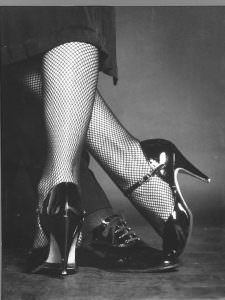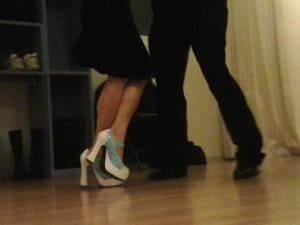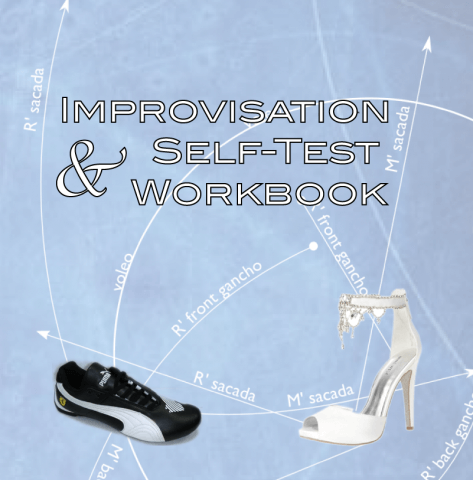Argentine Tango’s elegance is a breathtaking dream, gentlemen and ladies dressed for a grand ball, moving in unity as smooth as ice skaters, jewelery sparkling, legs flashing, heads regal like princes and princesses trained to support their crowns.
Twice recently, people who love and want to dance Argentine Tango have said to me “Well I can’t do it, because I’m not elegant.”
I felt sad, and shocked.
I want people to feel welcome in this dance, not already excluded because of their bodies or fashion skills.
The Fundamentalist mode has occupied the meaning and conceptualization of Argentine Tango, focusing on one facet, tango’s elegance. And this facet is not one which is empowering, but a disciplinary monotone.
Here are some of the other facets of our glorious jewel…
- an experience of profound human connection
- delightful romance
- a non-verbal language
- audacious improvisation
- musical playfulness, complexity, personality
- an unconditional and trusting embrace
- silent emotional consolation for irresolvable traumas (e.g. the Argentine dictatorship, see Julie Taylor’s book, Paper Tangos)
- a sophisticated dance vocabulary for creating a partner dance applicable to any music
- a social space for gentle and generous interactions
There are more. I am sure you can add to this list.
Heroin Chic
These days most performances I see vary by level, but not by ambition. Most dancers are doing the same dance, defined by the goal of elegance. They have lost completely the vision to differentiate themselves from others by expressiveness. They accept a single race, in monotone, to an already occupied throne.
This is a race to the tango equivalent of heroin chic, an emaciated caricature of the rich textures, colors, and shapes which tango can be. Just as the world learned that heroin chic was a danger to young girls like me who destroyed their lives with anorexia, we need to realize that the obsession with elegance is destroying people’s access to tango.
The message to the audience is exclusive, repetitive, and actually not that interesting. People who have musicality, emotion, and improvisational intelligence to share with us, but who may not see themselves in suits, heels, or extreme postures are driven away by these cliché images of tango’s elegance.
Avant Garde
I appreciate, even expect, elegance. I don’t recall seeing my mother in anything other other than an Yves Saint-Laurent suit or an evening gown and high heels until she was about 70. My grandmother continued wearing high heels into her 90s. Mom’s business was fashion, so I trained my aesthetic on the house bibles, Vogue and W.
I was programmed with a strict aesthetic of what counted as beautiful: hips like a boy, tiny breasts, chiseled cheeks, white skin. Thankfully the fashion world has since welcomed different skin colors, freckles, and some variation in the shape of the face. It’s still not considered beautiful to have breasts, hips, or athletic legs, and I continue to be ashamed of and judmental about such “flaws” (and can’t understand why girls are dancing in skirts that reveal every dimple of cellulite).
I carry this programming into assessing my tango. I worry that despite my purportedly extraordinary responsiveness (the Divine SpaceTime Machine technique), my knees are sometimes too far apart, or my concentration shows too much on my face. I am not one who works on tango as a pose, as an image. I work on the movement, sublime connection, the relation, and the possibilities for communication and maximum improvisation. Then, watching my videos, I beat myself up, frame by frame, for not achieving the perfect elegance of Juana and Eugenia.
My fans and friends comfort me by saying “what you do is another kind of beautiful” – which actually doesn’t comfort me at all, because it seems they concur that my tango is not conventionally elegant. I am so frustrated by this. With all my skills, why can’t I create any image I want? Why do I always look athletic, instead of mastering tango’s elegance? One of the cruelist things anyone ever said to me was a Porteña friend, casually in a milonga, “I don’t understand it. You have such an amazing body, why can’t you dance?” (Obviously I was dancing, intensely, at a high level, but I didn’t –and don’t– look “right”.)
Judith Preuss said in an interview with me “Tango is not about being beautiful! It’s about expressing yourself!” I agree, but I don’t stop feeling bad for not being able to do both, in every frame.
Both. Because I’m not satisfied with skinny beauty alone. My exposure to high fashion included an appreciation for sculptural, avant-garde clothing, clothing which has something to say beyond revealing an hourglass body. I want to see beauty in a way that I’ve never seen before.
If you want to see more of my taste, check my pinterest fashion board.
Other meanings of Elegance
In engineering, an ‘Elegant Solution’ is simple yet effective, innovative and consistent with principles. Check 0:57 below.
In leadership, I believe the correct term is ‘Grace’ –a mix of generosity, gratitude, and joy, which Pablo and Dana radiated and inspired – in sneakers.
Dancing in Real Shoes
Tango is a subculture, which means it has its own peculiar customs and rules, gleefuly out of sync with mainstream culture. These include retro gender relations, arcane music, and a cliché aesthetic with no relation whatsoever to contemporary fashion and sensibilities.

Tango teachers like me struggle mightily to advertise Argentine Tango to new students. Most of us indulge a pathological blindness to the gap between the perspective of prospective dancers and the sentiments of people who’ve continued dancing for some years despite all the wierdness. We continue to advertise tango with suits, trashy red dresses slit to the thigh, in extreme physical poses, atop frightening high heels, to music which can only be described as esoteric.
We have already recruited all of the people who like this music and fashion, who appreciate the particularities of tango’s elegance, and who will put up with the antiquated social “rules”. If we want more students we need to learn about the real world.
I’ve been wearing extreme stilettos since I was 14 years old and am totally comfortable walking in them. This is not the experience of most women.
In the real world there are women who are athletic, and would make very fine tango dancers, and they do not want to wear all this “elegant” clothing. We need to show them that tango is athletic and challenging and can be done very well in most sneakers.
Also in the real world there are lots of women who are into high heels and fancy clothes, but generally don’t walk well in their heels, and we could teach them how. However, they may not care. They are dressing up and going to bars and having a good time and they do not need tango. (The tribe of people who need tango are the ones who do not like or are not successful in bars.)
 The dressy-up women who might want to come dancing in high heels are not going to be attracted to tango shoes, which are pathetically out of fashion, and below the heel height which is sexy. (Tango shoes stop at 9cm, sexy starts around 10 and go up from there with platforms.)
The dressy-up women who might want to come dancing in high heels are not going to be attracted to tango shoes, which are pathetically out of fashion, and below the heel height which is sexy. (Tango shoes stop at 9cm, sexy starts around 10 and go up from there with platforms.)
(Anyway no one should be encouraged to wear 3cm heels appropriate only for grandmothers at weddings.)
Dancing for dancers
Yesterday I attended an event called “Crossover Dance Battle: The Tango Edition”. I expected a wild episode of Asian hiphopsters doing their idea of gymnastic tango to dubstep. Instead it was a room full of contemporary dancers, mostly women adorned with gym clothing and ponytails. The first part of the evening was demonstrations by professional tango dance couples. Three of the four tango couples made the usual pathological choice for high heels, tuxedos, and hourglass sequin dresses. (One couple, mixing contact improvisation with tango, had the good sense to be relatable by dancing in leggings, tshirts, and socks.)
After the choreographed tango demonstrations came the second part of the evening, “all styles solo battles”. Audience members had signed up at the door for one minute of improvisation on the DJ’s selection. An equal number of men and women of took the floor in baggy tshirts, street sneakers, and pants. One of the finalists was an Asian woman who displayed extensive ballet and contemporary dance training, along with hiphop sensibilities, with a body that was not at all skinny.
This girl is an emissary from the real world of dance to the tango dancers. Rigid aesthetics, like tango’s elegance, blocks diversity in our dance.
Dancing for musicians
The week prior to this event I had the extraordinary opportunity to dance 5 nights sequentially with Duo Santos Bruno, two of the musicians of Orquesta Ciudad Baigone. We performed together in bars, cafés, and milongas. The first episode was in the basement of a bar in Mitte, on a broken cement floor. The musicians gestured at us, pointed at the dance floor, then detached their electronics and came off the stage to join us there. The four of us moved around one another within a 2m2 space, performing together, bandoneón, voice, and two dancers. Afterwards, Ignacio Santos said “you were dancing to the music!” I said “you were improvising with us!”
We were so profoundly moved by the artistic experience that by the end of the week we had named it: “Los Quatro”.
The musicians repeated what I have heard from other tango musicians who told me why they don’t really like to play in milongas or with show dancers, “the dancers don’t seem to pay attention to our music.” Most dancers are more concerned with maintaining tango’s elegance than with having a real experience of connection with the musicians.
As a dancer, to step into unknown music is a risk. It means to leave the idea of perfection and elegance behind, for the dance, and for a dance truly articulated by the music.
Dead-end elegance
I am a child of elegance. I took the world of high fashion to heart and was anorexic by age 15. Anorexia never entirely loses its cruel grip on the psyche. When I watch my videos I hardly see the dancing, I only see the fat on my tummy. Anorexia is a relentless shape shifter who distorts perception and who can adjust her hard lens to any aspect of my being – my less-than-MaestraX’s flexibility, the intolerable persistent imperfection of my back ochos, an insatiable to-do list… I cannot even see what I do well, the gifts that I give, what is unique about me.
What saves me from the chokehold of anorexia is the legacy of an early and rich art education, during which somehow I developed a fiery drive to create that reliably overwhelms both self-doubt and good sense. And thereby I dance to and beyond the edges of my physical and emotional capacities every time I dance.
Not everyone is graced with a reckless drive to self-expression, and so those of us who stand at the gates of tango must also pay heed to the effects of tango’s elegance on prospective dancers’ access to all the other facets of tango.
And those of us who see tango as art need to realize that a disciplinary aesthetic like elegance has logic and consequence. It doesn’t free you, it blinds you to reality, to possibility, to self-expression, to what can only come with risk … to real art.






















